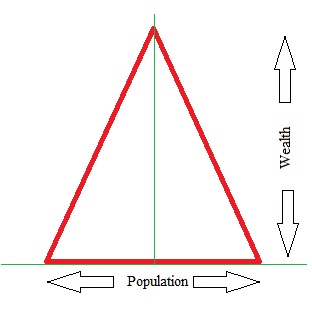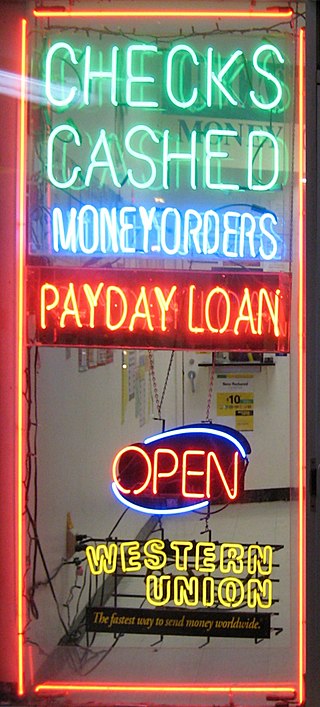Related Research Articles

Microcredit is the extension of very small loans (microloans) to impoverished borrowers who typically lack collateral, steady employment, or a verifiable credit history. It is designed to support entrepreneurship and alleviate poverty. Many recipients are illiterate, and therefore unable to complete paperwork required to get conventional loans. As of 2009 an estimated 74 million people held microloans that totaled US$38 billion. Grameen Bank reports that repayment success rates are between 95 and 98 percent.

Microfinance is a category of financial services targeting individuals and small businesses who lack access to conventional banking and related services. Microfinance includes microcredit, the provision of small loans to poor clients; savings and checking accounts; microinsurance; and payment systems, among other services. Microfinance services are designed to reach excluded customers, usually poorer population segments, possibly socially marginalized, or geographically more isolated, and to help them become self-sufficient. ID Ghana is an example of a microfinance institution.

Grameen Bank is a microfinance organization and community development bank founded in Bangladesh. It makes small loans to the impoverished without requiring collateral.
A financial intermediary is an institution or individual that serves as a "middleman" among diverse parties in order to facilitate financial transactions. Common types include commercial banks, investment banks, stockbrokers, insurance and pension funds, pooled investment funds, leasing companies, and stock exchanges.
Funding is the act of providing resources to finance a need, program, or project. While this is usually in the form of money, it can also take the form of effort or time from an organization or company. Generally, this word is used when a firm uses its internal reserves to satisfy its necessity for cash, while the term financing is used when the firm acquires capital from external sources.
Predatory lending refers to unethical practices conducted by lending organizations during a loan origination process that are unfair, deceptive, or fraudulent. While there are no internationally agreed legal definitions for predatory lending, a 2006 audit report from the office of inspector general of the US Federal Deposit Insurance Corporation (FDIC) broadly defines predatory lending as "imposing unfair and abusive loan terms on borrowers", though "unfair" and "abusive" were not specifically defined. Though there are laws against some of the specific practices commonly identified as predatory, various federal agencies use the phrase as a catch-all term for many specific illegal activities in the loan industry. Predatory lending should not be confused with predatory mortgage servicing which is mortgage practices described by critics as unfair, deceptive, or fraudulent practices during the loan or mortgage servicing process, post loan origination.

Credit is the trust which allows one party to provide money or resources to another party wherein the second party does not reimburse the first party immediately, but promises either to repay or return those resources at a later date. The resources provided by the first party can be either property, fulfillment of promises, or performances. In other words, credit is a method of making reciprocity formal, legally enforceable, and extensible to a large group of unrelated people.
The terms poverty industry or poverty business refer to a wide range of money-making activities that attract a large portion of their business from the poor. Businesses in the poverty industry often include payday loan centers, pawnshops, rent-to-own centers, casinos, liquor stores, lotteries, tobacco stores, credit card companies, and bail-bond services. Illegal ventures such as loansharking might also be included. The poverty industry makes roughly US$33 billion a year in the United States. In 2010, elected American federal officials received more than $1.5 million in campaign contributions from poverty-industry donors.

The bottom of the pyramid, bottom of the wealth pyramid, bottom of the income pyramid or the base of the pyramid is the largest, but poorest socio-economic group. In global terms, this is the 2.7 billion people who live on less than $2.50 a day.
Financial deepening is a term used by economists to refer to increasing provision of financial services. It can refer both a wider choice of services and better access for different socioeconomic groups. Financial deepening can have an effect on both individuals' and societies' economic situations.

Kiva Microfunds is a 501(c)(3) non-profit organization headquartered in San Francisco, California. Kiva's mission is "to expand financial access to help underserved communities thrive."
A rotating savings and credit association (ROSCA) is a group of individuals who agree to meet for a defined period in order to save and borrow together, a form of combined peer-to-peer banking and peer-to-peer lending. Members all chip in regularly and take turns withdrawing accumulated sums.

Solidarity lending is a lending practice where small groups borrow collectively and group members encourage one another to repay. It is an important building block of microfinance.

A self-help group is a financial intermediary committee usually composed of 12 to 25 local women between the ages of 18 and 50. Most self-help groups are in India, though they can be found in other countries, especially in South Asia and Southeast Asia. A SHG is generally a group of people who work on daily wages who form a loose grouping or union. Money is collected from those who are able to donate and given to members in need.
Zidisha allows people to lend small amounts of money directly to entrepreneurs in developing countries. It is the first peer-to-peer microlending service to link borrowers and lenders across international borders without a local microfinance institution intermediary. The organization is named after the Swahili word zidisha, which means "grow" or "expand".

An alternative financial service (AFS) is a financial service provided outside traditional banking institutions, on which many low-income individuals depend. In developing countries, these services often take the form of microfinance. In developed countries, the services may be similar to those provided by banks and include payday loans, rent-to-own agreements, pawnshops, refund anticipation loans, some subprime mortgage loans and car title loans, and non-bank check cashing, money orders, and money transfers. It also includes traditional moneylending by door-to-door collection. In New York City, these are called check-cashing stores, and they are legally exempted from the 25 percent criminal usury cap.

Women's World Banking is a nonprofit organization that provides strategic support, technical assistance and information to a global network of 55 independent microfinance institutions (MFIs) and banks that offer credit and other financial services to low-income entrepreneurs in the developing world, with a particular focus on women.
Energy in Common (EIC) was a not-for-profit organization issuing microloans specifically and only for renewable energy technologies. EIC was founded by Hugh Whalan and Scott Tudman in 2009. It has the very ambitious goal of delivering renewable energy to 15 million people in the next five years, while fighting poverty by empowering developing world entrepreneurs through microloans. EIC represents one of the most promising contenders in the growing green microfinance sector. As of 2012, it has ceased operations due to a lack of funds after their overseas partners defaulted on their loan obligations.
Collaborative finance is a category of financial transaction that occurs directly between individuals without the intermediation of a traditional financial institution. This new way to manage informal financial transactions has been enabled by advances in social media and peer-to-peer online platforms. The wide variety of collaborative finance resources may vary not only in their organizational and operational aspects, but also by geographical region, share of the financial market etc. It is precisely this heterogeneity that enables the informal savings and credit activity to profitably reach those income-groups not served by commercial banks and other financial institutions. It is their informality, adaptability and flexibility of operations – characteristics which reduce their transactions costs and confers upon them their comparative advantage and economic rationale. Collaborative Finance is characterized by highly personalized loan transactions entailing face-to-face dealings with borrowers and flexibility in respect of loan purpose, interest rates, collateral requirements, maturity periods and debt rescheduling.
The impact of microcredit is a subject of much controversy. Proponents state that it reduces poverty through higher employment and higher incomes. This is expected to lead to improved nutrition and improved education of the borrowers' children. Some argue that microcredit empowers women. In the US and Canada, it is argued that microcredit helps recipients to graduate from welfare programs. Critics say that microcredit has not increased incomes, but has driven poor households into a debt trap, in some cases even leading to suicide. They add that the money from loans is often used for durable consumer goods or consumption instead of being used for productive investments, that it fails to empower women, and that it has not improved health or education.
References
- 1 2 3 4 The Theory of Financial Intermediation, by Franklin Allen and Anthony M. Santomero
- ↑ Arp, Frithjof; Ardisa, Alvin; Ardisa, Alviani (2017). "Microfinance for poverty alleviation: Do transnational initiatives overlook fundamental questions of competition and intermediation?". Transnational Corporations. United Nations Conference on Trade and Development. 24 (3): 103–117. doi:10.18356/10695889-en. hdl: 10419/170696 . S2CID 73558727. UNCTAD/DIAE/IA/2017D4A8.